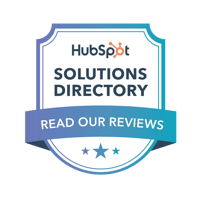Running an inbound marketing campaign is a heavy lift, but it's a great way to generate more qualified leads for your business.
But part of the success of an inbound campaign is being able to track ROI to benchmark performance. What came out of your inbound marketing efforts? Answering that question is the first step to measuring success and planning for future efforts.
There are two primary ways to track your ROI from an inbound marketing campaign: through conversions or via goals. Let's walk through each one so you can start seeing what your inbound marketing is getting you.
Related Content: What is EEAT: The Inbound Marketing Powerhouse You Can't Ignore
Refresher: What is Inbound Marketing?
Inbound marketing is a modern approach to digital marketing. Instead of casting a wide net and trying to chase down customers, inbound marketing focuses on attracting your ideal customers who are most likely to convert into sales.
Related Content: What's the Difference Between Digital Marketing and Inbound Marketing?
The inbound methodology is based on the concept of a flywheel, including phases that overlap and feed each other. The flywheel serves as the framework of your inbound campaigns. It helps you understand what specific pieces of content and what specific offers will resonate with a buyer based on where they currently sit in the flywheel:

- Attract: Earn your audience's attention, don’t force it. Attract visitors with useful content and eliminate barriers as they try to learn about your company.
- Engage: Open relationships, don’t just close deals. Enable buyers to engage with you on their preferred timeline and channels. Tie sales incentives to customer success, not just close rate.
- Delight: Tie your success to your customers. Shift resources to be more effectively distributed throughout the entire customer experience.
Related Content: How to Get Started with Inbound Marketing
How to Track Inbound Marketing ROI
Method 1: ROI Tracking Through Conversions
Compared to other digital marketing efforts, tracking an inbound marketing campaign's success is typically more straightforward. Generally, your goal with an inbound marketing campaign is to get someone to download a guide, checklist, video or other piece of content.
This means that you'll have a list of conversions - people who filled out the form on your landing page or took the other desired action of the inbound marketing campaign.
This also means you can usually perform a few simple calculations to determine ROI.
| Calculate Cost to Acquire a Lead |
| Total Spent on Online Ads ÷ Number of Conversions = Cost to Acquire a Lead |
While this number is useful, you may also find that you generate a few conversions that are not actually relevant - whether that's spam submissions or just leads that don't fit your target market.
It's also important to look at sales-qualified leads. Sales-qualified leads are leads that have been reviewed by your sales team and verified to be relevant and valuable. Calculating this number is useful for figuring out how much money it takes to find relevant leads.
| Calculate Cost to Acquire a Sales Qualified Lead |
| Total Spent on Online Ads ÷ Number of Sales-Qualified Leads (SQL) = Cost to Acquire an SQL |
Once those SQLs become a sale, then you can do your final ROI calculation:
| Calculate ROI of an Inbound Marketing Campaign |
| Total Gross Revenue from deals originated from Inbound Marketing Campaign - Total Spent on Online Ads = Monetary Return on Investment |
Another way to calculate ROI through conversions is by finding your conversion rate. That's taking an additional step back to see how many people who landed on your landing page actually took that next action.
| Calculate Conversion Rate |
| Total Views of Your Landing Page ÷ Number of Conversions x 100 = Conversion Rate |
You can calculate conversion rates from specific sources as well, for example, starting with a number of clicks on a Facebook ad and then dividing it by the number of conversions.
Knowing your conversion rate is useful in comparing against industry benchmarks to determine how well your inbound marketing campaign is performing. WordStream has a comprehensive list on their website of average conversion rates by industry and platform.
Note: Doing cost calculations based on your online advertising budget is typically the most straightforward way to determine ROI. However, if you want to go even deeper you can look at the "cost" of your other marketing efforts like promoting your inbound asset through blogs, social and email. In order to make that calculation, you need to track how many hours your team spent creating these marketing efforts, and use that number as your "cost."
ex: Our team spent a collective 80 hours on the inbound marketing project ÷ We got 10 SQLs = Our "cost" to acquire an SQL was 8 hours of work per lead.
You can also do that calculation based on revenue, which looks a little like this:
| Calculate Hours vs. Revenue |
|
1. Total Gross Revenue from deals originated from Inbound Marketing Campaign |
Method 2: ROI Tracking Against Goals
The most important element of any marketing strategy is having a clearly defined goal. For most campaigns, the goal is to land conversions.
An inbound campaign might also include other goals, such as increasing organic website traffic for a search term.
The best way to create goals for inbound marketing is using the SMART goals template. SMART goals are:
- Specific – Your goal needs to be unambiguous and clear.
- Measurable – You should define a concrete way of measuring progress toward your goal.
- Attainable – It needs to be realistically achievable for your team.
- Relevant – Your goal needs to make sense for your business and overall business goals.
- Timely – It’s important to set a time limit on goals to keep them in check.
For example, an inbound marketing goal unrelated to conversions could be:
For every 100 visitors to our landing page, I want 2 to sign up for blog notifications within a 6 month time period.
This way of tracking Inbound Marketing ROI is less of a focus on the specific revenue from your inbound efforts.
Using these tactics, you can clearly track ROI for any inbound marketing campaign. It's critical to be able to tweak your inbound marketing campaign to maximize conversions by having a solid baseline of ROI.
Inbound Marketing with BizzyWeb
BizzyWeb creates powerful inbound campaigns for our clients and provides education so our clients can become powerful inbound marketers themselves. As a HubSpot Partner Agency, we rely on the power of HubSpot’s suite of inbound-ready tools to execute these tactics. Learn more about our inbound marketing services here.
BizzyWeb is a Minneapolis-based digital marketing and web design agency that helps companies get the high-quality leads they need to grow and thrive. Our tactics include inbound marketing, SEO, advertising, web design, content creation and sales automation. We are an accredited HubSpot Diamond Partner and we offer full-service HubSpot onboarding, enablement and strategy for new and current users.





